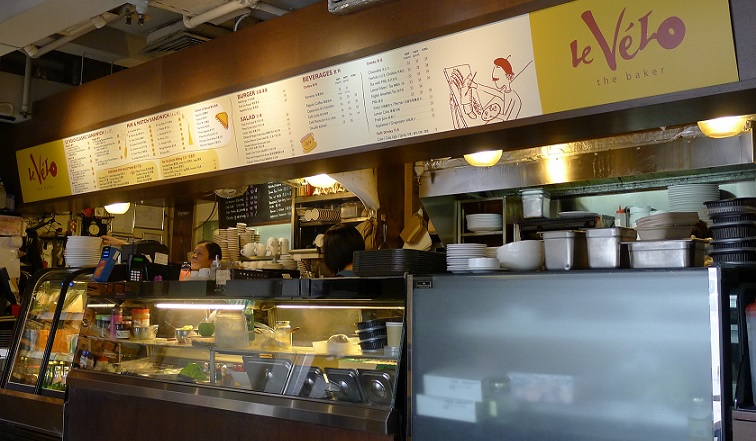藝評
美好的早晨 | Good night and good mornings
約翰百德 (John BATTEN)
at 3:17pm on 27th January 2019

圖片說明Caption:
香港中環的Le Vélo咖啡座 Le Vélo café, Central, Hong Kong
圖片Photo: 約翰百德 John Batten
(Please scroll down for English version)
剛剛讀過美藉日裔雕塑家野口勇的傳記,才記起自己忘了野口也是創意傢俱設計師,擁有自己的 Akari幾何/雕塑紙燈系列,是他1951年首次到訪日本岐阜市後所設計的作品。岐阜市素來與生產傳統竹燈與紙燈息息相關。我在1990年也到過岐阜參觀這些燈飾設計,當中不少均以野口的設計為原型。野口首批現代主義燈飾針對出口市場,燈框採用了彈性鐵線而不是竹蔑製成,光源也用上了電燈膽而非蠟燭。野口對燈的著迷,大概在小時候居於日本時開始。他會說自己在看到月亮出來前無法睡著。後來與他疏遠的父親於是設計了一個燈影裝置來描繪月亮,讓小野口透過分隔鄰房的趟門看到。
現於西九文化區 M+展亭舉行的展覽《對位變奏:野口勇之於傅丹》,正在展出野口的雕塑與設計作品,同場並展出丹麥藉越南裔藝術家傳丹的作品。書讀過了,是時候前往M+的展覽,詳情如下!
如果你想深入認識某像野口一樣偉大藝術家的課題、題目,又或生平,只有一本載有詳細資料與分析的優質著作–– 配合親身欣賞其作品 –– 才可以實現。相對來說,過去幾星期的報章上,我一直只讀到剛過去一年的各種回顧文章,好像年度最佳書本、最好吃的菜色、最優秀的電影、最佳美酒、好與不好的旅遊驚喜、音樂亮點、政治概要、金融市場預測(永遠都是市場預測)、令人興奮的展覽(在藝術世界中,「我們深感興奮……!」是藝術家樂見的感嘆)。另一方面,成績平平的展覽鮮有人撰文記錄,落得被遺忘的下場。然而,報章的食評實在著墨太多,特別是那些定價過份昂貴,被人過度吹捧的餐廳。除了在開飯網站,你有多常看到平凡踏實食肆的評論?
我每天早上都喜歡享受一頓簡單的早餐,一面吃多士喝咖啡、一面讀報。我通常會到茶餐廳吃早餐,上環一帶約有八間可選。到了星期六,這個早上習慣的開始時間較晚,會變成像早午合餐一樣,有時候會到皇后街熟食市場吃些北京餃子,又或是一份三文治。如果要頒發實而不華咖啡座大獎,來表場供應全城最佳(及最物有所值)三文治,備有不同麵包選擇的店,我會頒給Le Vélo。它會讓你起可以在日本看到的本地咖啡店,樸實而不造作,店內供應各種報章雜誌讓客戶取閱。Le Vélo位於上環與中環之間人煙罕至的路段。如果你由上環港鐵店向中環方向走,經過永安和先施兩間百貨店的後門,再走過中旅社,你便來到恒生銀行外,那麼你便會錯過這家咖啡店了!這裡的三文治真的非常出色,很值得你走回頭路去把它發掘出來。
返回正題。我剛開始拜讀Anna Burns榮獲布克獎的作品《Milkman》。故事發生在1970代後期,是文筆緊湊的意識流風格小說,以北愛爾蘭的「動盪」時期為背景,由一位愛閱讀的18歲少女以敏銳的觀察娓娓道來。小說關係到不著邊際的情況和對話,有些令人生畏,有些則是生活日常,例如是坐巴士看著日落時,在其他乘客身上的所見所聞:
「我不明白的不只是日落。我不明白星星,或是月亮,或是清風,或是朝露,或是花朵,或是天氣,或是某些人所抱著的熱望––老人家所抱著的––對於他們什麼時候上床睡覺,翌日什麼時候起床,還有外面的攝氏與華氏溫度是多少,室內的攝氏與華氏溫度又是多少,他們的便便、他們的消化道、他們的雙足、他們的牙齒狀態如何,其中一位老人家在擠迫巴士上大聲地說:『你知道嗎?回家吃晚飯前,我會先吃一片香脆的多士。』而同行的人同樣大聲地回答:『回家吃晚飯前,我也會先吃一片香脆的多士。』如果不是這樣,便會是:『你昨天有在家吃過一片香脆的多士嗎?』」
一片香脆的多士配上咖啡與閱讀。美好早晨,乎復何求!
參考資料:
|www.westkowloon.hk/tc/counterpoint
www.facebook.com/levelobakery
原文刊於《明報周刊》,2019年1月5日
Good night and good mornings
by John Batten
I have just finished reading a biography about the American-Japanese sculptor Isamu Noguchi. I had forgotten that Noguchi was also an innovative designer of furniture and his own line of Akari geometric/sculptural paper lamps, designed following his first visit in 1951 to Gifu, the Japanese city long associated with the traditional manufacture of bamboo and paper lanterns. I made a similar visit to Gifu in 1990 to see these paper lighting designs, many of which emanated from Noguchi’s originals. Targeting an export market, Noguchi’s first modernist lamps used flexible wire framing instead of bamboo strips and were lit by electric light-bulbs instead of candles. Noguchi’s fascination with light supposedly began when as a small boy living in Japan, he would say that he couldn’t sleep until he saw the moon. His father, later estranged from the sculptor, devised a light and shadow arrangement depicting the moon and seen by a young Noguchi through the dividing shoji screens of the adjacent room.
Now on exhibition at the M+ Pavilion at the West Kowloon Cultural District is a selection of Noguchi’s sculpture and design items, alongside work by Danish-Vietnamese artist Danh Vo. My reading complete, I can now visit the M+ exhibition – details below!
If you really want to get your head around a topic, issue, or, say, the life of a great artist, such as Noguchi, only a quality book, with details and facts and analysis – alongside seeing the actual art - will give it to you. In contrast, for the past weeks in the ‘papers I have been reading reviews of the recently concluded past year. Best books read, best eaten dishes, best films seen, best wine, travel surprises good and bad, musical highlights, political summaries, financial market predictions (always market predictions), exhibitions that excited (in the art world, “we are excited…!”, is a favoured exclamation). On the other hand, exhibitions not so good are rarely written about and just forgotten. However, too much space is devoted to restaurant reviews, especially of over-priced, over-hyped restaurants. How often do you read a review of a normal, no-frills place (except on Open Rice’s website)?
One of my daily pleasures is having a simple breakfast of toast and coffee whilst reading a newspaper. I usually go to a local cha chan teng, of which there are about eight to choose from around Sheung Wan. However, my morning ritual on Saturdays starts a little later and is a sort-of brunch that invariably includes Beijing-style dumplings at the Queen Street Market or, sometimes, a sandwich. My award for best no-frills café that serves the best (and best-value) sandwiches, with a choice of different breads, in Hong Kong is Le Vélo. It is the sort of good no-frills local café you would find in Japan, including having a range of magazines and newspapers for customers to read. Le Vélo is located in that no-man’s land between Sheung Wan and Central on Connaught Road. So, if you walk towards Central after exiting the Sheung Wan MTR Station, past the rear of Wing On and Sincere Department Stores, and the China Travel office, and you arrive outside Hang Seng Bank, then you have missed it! It is worth doubling-back again, the sandwiches are good!
On topic, I have just started reading Anna Burns’ Booker Prize-winning Milkman. Set in the late-1970s, a tightly-written, stream-of-consciousness style novel set in Northern Ireland during “the troubles” as told by a sensitive, observant eighteen-year old, a young woman who is also an avid book reader. The novel relates rambling situations and conversations, some horrific and terrifying, and some of daily life. Such as after seeing a sunset she sits on a bus, observing, overhearing other commuters:
“It wasn’t just sunsets I didn’t understand. I didn’t understand stars or moons or breezes or dew or flowers or the weather or the avidity some people took – older people took – in what time they were going to bed at, and at what time the following day they were going to get up at, also what Celsius and Fahrenheit temperature it was outside, and what Celsius and Fahrenheit temperature it was inside, and the state of their bowels, their digestive tracts, their feet, their teeth, where one of them says loudly on the crowded bus, ‘Do you know what? I’ll have a nice slice of toast when I go home before my dinner,’ and where the companion replies equally loudly, I’ll have a nice slice of toast in my house as a start before dinner too.’ If not that, then it’s ‘Did you have a nice slice of toast in your house yesterday?’”
A nice slice of toast and coffee and reading. That’s a good morning!
Links for further info:
www.westkowloon.hk/tc/counterpoint
www.facebook.com/levelobakery
This article was originally published in Ming Pao Weekly, 5 January 2019. Translation from English to Chinese: Aulina Chan.
